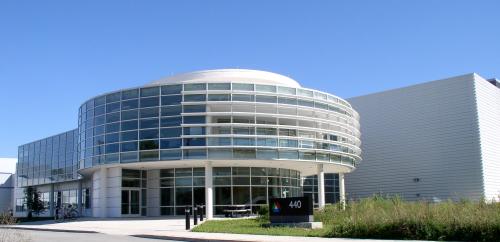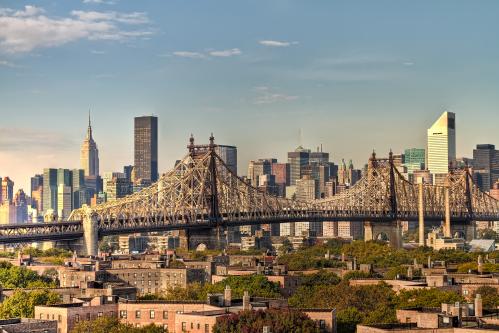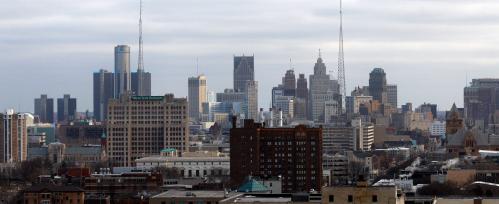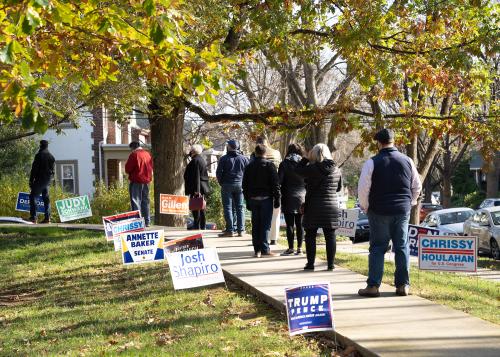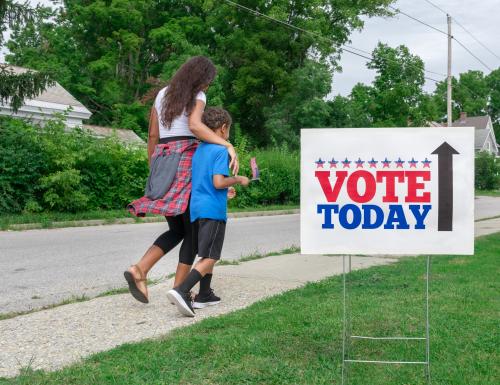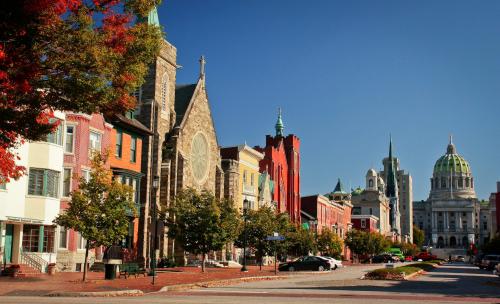The following brief is part of Brookings Big Ideas for America—an institution-wide initiative in which Brookings scholars have identified the biggest issues facing the country and provide ideas for how to address them. (Updated February 2, 2017)
Over the past decade, American cities and metropolitan areas have firmly established themselves as the engines of the nation’s economy and as the centers of technological innovation and global trade and investment.1 Donald Trump’s election and Republicans’ continued control of the House and Senate put cities in uncharted territory.
Our country is facing a convergence of massive economic, demographic, and environmental challenges. The global economy becomes more competitive by the day while economic mobility at home remains stagnant. Our elderly population is growing while underserved minority groups represent a larger share of our nation. The effects of climate change disrupt the functioning of our society ever more frequently and dramatically.
These unprecedented challenges will not be overcome without an array of new investments. We must spur innovation through greater contributions to basic science and applied research, entrepreneurial startups, and business incubators and accelerators. We must improve the standing of our middle- and lower-income populations, not just through higher wages and more affordable housing but also through greater educational investments in specialized high schools, community colleges, and vocational training. We must provide a strong platform for sustainable growth through new transportation, energy, water, and other infrastructure. Yet even by conservative estimates, these investments will cost trillions of dollars over the next decade.2 This “investment gap” should be at the forefront of policymakers’ minds on both sides of the aisle.
Republicans’ 2016 election victories at the federal and state level suggest that cities and metropolitan areas will be increasingly on their own in making these investments. In contrast to the partisan gridlock that characterized much of President Obama’s time in office, Washington is now poised for a burst of conservative legislative and administrative activism not seen in decades. In a few areas, like infrastructure and defense spending, it is conceivable that greater federal investments will be forthcoming. But for the most part, the Trump era looks as if it will usher in a toxic mix of tax cuts, reductions in several types of entitlement spending, and policy shifts— like reducing our commitment to mitigating climate change—damaging to our long-term national interests. If this is the case, the responsibility for addressing major societal challenges will fall to local and metropolitan actors like never before.
the new american localism
As partisan gridlock paralyzed the federal government during President Obama’s time in office, cities and metropolitan areas developed the capacity to take matters into their own hands. A New American Localism has emerged, filling the vacuum created by Washington’s departure from normal functioning. Local cross-sector networks have joined together to become the vanguard of national problem solving and policy innovation. They are taking on issues as diverse and complex as economic competitiveness, social mobility, climate change mitigation, and immigrant integration.
Signs of this New Localism can be seen throughout the nation. Montgomery County, Maryland and Sacramento and San Jose, California are reducing income inequality by raising the minimum wage. Broward County in Florida, King County in Washington, and San Antonio, Texas, are generating hundreds of millions of dollars in local revenues to provide children with high-quality early education and other proven programs. In this election cycle, voters in Columbus, Ohio; Los Angeles; and Seattle approved $180 billion in additional taxes to spur ambitious transit expansions and more sustainable patterns of development. Private and civic investors in Indianapolis, Pittsburgh, and St. Louis are sharpening relationships between universities, companies, entrepreneurs, and business incubators, turning their cities into global centers of cutting-edge technology. These examples represent just a few of the places creating innovative solutions to our toughest problems. Every day brings new bottom-up approaches to improving the well-being of our communities.

The emergence of New Localism is particularly potent given the fact that our nation’s 388 metropolitan areas house 84 percent of our population and generate 91 percent of our GDP. The top 100 metropolitan areas alone contain two-thirds of our population and generate three-quarters of our GDP.3 The bottom line: as metropolitan areas succeed, so does the nation.
While the federal government must lead in many areas of national life—protecting the homeland, maintaining a strong military, providing a robust safety net for the elderly and disadvantaged, setting sensible immigration policies, ensuring civil rights, and investing in basic science—our federalist system is an exercise in shared power. In many of the matters most critical to our future prosperity and shared growth, Washington is a small player, providing, for example, only 12 and 25 cents of every public dollar spent on K-12 education and transportation infrastructure, respectively.4 State and local actors play a much more important role in promoting the vitality of our businesses, the education of our children, the quality of our infrastructure, the vibrancy of our public spaces, and the skills of our workers.
By definition, localism manifests itself differently in every community across the nation. But the leading examples of the New American Localism share a number of common principles and characteristics. First, cities and metropolitan areas are addressing tough issues through the full power of their government, business, civic, philanthropic, university, and community networks. This contrasts with the old approach, which relied on public-sector solutions alone and focused on more traditional federalist relationships between levels of government (particularly the federal government and the states). Second, cities and metropolitan areas are forging their own responses to local problems that are holistic, multidisciplinary, and guided by community priorities. Spurring a local economy, improving outcomes for disconnected youth, or improving economic mobility require comprehensive, tailored approaches to the specific circumstances at hand. This energetic response sharply contrasts with strategies employed in the past—taking on problems through siloed, narrowly defined, one-size-fits-all programs often administered by slow-moving, inflexible federal agencies.5Finally, cities and metropolitan areas are rethinking their approach to financing public activities by raising, pooling, and deploying capital from an array of local, national, and even global sources. They have recognized that rising mandatory spending at the federal level will inevitably push down spending on infrastructure, education, and other competitive levers, and that rising demand and population growth require greater investments and new forms of innovative finance.
Taken together, New Localism has demonstrated the power of metros to invest in solutions to our toughest problems, boost our economy, and generate quality jobs. It represents a striking contrast to the economic insecurity and fears about globalization that drove the 2016 election.
BRIDGING THE URBAN-RURAL DIVIDE
Economic dynamism aside, metropolitan areas are also the level at which our nation will bridge the chasm between cities and rural areas as well as racial and ethnic groups. The 2016 election showed that our country needs more than jobs and economic security. Overcoming the divides in our society cannot be achieved from our nation’s capital.
Unlike politics at the national level, metropolitan areas unite geographies and disparate groups.
Unlike politics at the national level, metropolitan areas unite geographies and disparate groups. They encompass central cities, suburbs, exurbs, and, due to sprawling development patterns, hundreds of rural communities. Fully half of the people living in rural areas are actually part of greater metropolitan regions.6 All within a specific metro area are bound together by shared labor and housing markets. They are stuck in the same traffic jams, they root for the same sports teams, and they share an interest in improving their mutual quality of life.
Localism engages stakeholders across ideological and jurisdictional lines. In communities like Denver and Minneapolis/St. Paul, Democrats and Republicans have learned to do at the metropolitan level what they seem incapable of doing at the national level: namely, recognizing common interests and compromising to get things done. It is not always easy and there are often loud, impassioned detractors. But local community networks, unlike ideologically rigid national parties, ultimately reward action and punish obstruction.

Particularly in this time of raw division, metropolitan communities need to perfect a new style of collaborative governance, one that works across jurisdictions and alongside businesses and civic institutions. Coming together as a nation is not solely dependent on the federal government getting its act together—cities and metros have enormous potential here that has yet to be realized.
what do metropolitan areas need from the trump administration?
Historically, presidential administrations have taken too narrow a view of “urban policy.” In reality, issues as diverse as health care, immigration, research and development, and climate change are all “urban” in their impact. Our cities must be vigilant in articulating the ways that changes to these policies will affect their communities. As the Trump administration begins to develop its policy platform, cities and metropolitan areas need to insist that the federal government lead where it must.
Cities and metropolitan areas need to insist that the federal government lead where it must.
Many of the disruptive forces affecting communities across the nation—global trade, wage stagnation, technological change, environmental tumult, and international migration—transcend parochial borders and require thoughtful policymaking at the federal level. The Trump administration must see its core job as acting with vision, direction, and purpose on the things that cities and metropolitan areas cannot do on their own.
Many of the president-elect’s campaign positions on platform issues like health care, immigration, and climate change are deeply troubling. Repealing the Affordable Care Act would take away health care from millions of Americans and shift responsibility for emergency care back to local governments, likely swamping local budgets that are already under enormous stress.7 Reversals of climate policy could remove valuable incentives for investments in renewable energy. Shifts in immigration policy could divide communities, remove badly needed workers from local businesses, and distract local leaders from the many more pressing issues at hand. Cities and metropolitan areas need to describe—with evidence, granularity, and vigor—the implications of changes to these policies. Then they need to engage in the legislative debate with a unified voice, raising practical and widespread concerns that cross the artificial boundaries of cities, counties, suburban municipalities, and rural towns.
Cities and metropolitan areas need to describe—with evidence, granularity, and vigor—the implications of changes to these policies. Then they need to engage in the legislative debate. Ideally, our urban communities would find a way to speak with one voice, raising practical and widespread concerns that cross the artificial boundaries of cities, counties, suburban municipalities, and rural towns.
Second, cities and metropolitan areas need to demand that the federal government empower where it should. Given the extent to which cities have improved their performance over the past decade or so, President-elect Trump has a unique opportunity to reform Washington’s relationship with metropolitan areas. He should consider providing them with greater flexibility to adapt federal discretionary investments in transportation, housing, workforce development, education, and other areas to their specific needs and local priorities. The resources the federal government provides to local areas are heavily prescriptive and compartmentalized, reaching their intended communities through stovepiped funding mechanisms that often roll out incoherently. This approach is fundamentally out of sync with the way problems are actually solved at the local level. Our metropolitan areas should call for greater flexibility in exchange for greater accountability. Any change in the provision of federal resources should be based on the principle of making federal investments more effective, not reducing their size. With the same total quantity of resources but more flexibility in how resources are spent, locally designed approaches have the potential to be more effective than federally administered ones.
President Trump and Congress should consider emulating the “City Deals” and devolution agreement process under way in the United Kingdom, which has created a vehicle for British cities to gain greater discretion in how central government funds are used locally.
President Trump and Congress should consider emulating the “City Deals” and devolution agreement process under way in the United Kingdom, which has created a vehicle for British cities to gain greater discretion in how central government funds are used locally.8 To qualify for a City Deal, British cities propose distinct plans for how centrally provided resources might be better allocated around a specific purpose. If they are able to make the central government “an offer it cannot refuse,” they are granted the flexibility to carry out their strategy. Congress could authorize a similar process, providing the opportunity for metropolitan areas to “apply” for the ability to allocate federal discretionary resources to a specific social, economic, or environmental outcome. This contrasts with the current system, where cities are forced to find ways to fit many small federal grants with rigid determinations into a coherent local strategy. City Deals—perhaps more appropriately labeled “Community Deals” in the United States—could better align federal resources with local priorities, fully unleash the problem-solving creativity of local actors, and correct the notion that the dizzying array of small federal grant programs provided to local governments can somehow match the drastically varying needs and conditions on the ground. Community Deals could also provide a vehicle for greater cross-party collaboration, as it would incentivize negotiation between local coalitions (often led by Democrats) and the Trump administration.
Finally, cities and metropolitan areas should demand that the federal government help leverage private and civic capital to the maximum extent possible. As described above, our nation needs dramatically greater investments in a range of policy areas, and these funds cannot be provided exclusively by the public sector. President-elect Trump has, to date, recognized this new reality inconsistently. His still-evolving infrastructure agenda seeks to provide incentives to private investors to engage. But his tax proposals follow a more traditional Republican penchant for general cuts rather than ones designed to achieve specific leverage.
From a city and metropolitan perspective on infrastructure, several things are clear.
- The infrastructure deficit is very deep and differs from place to place. Reliance on tax incentives might favor certain revenue-raising investments (such as toll roads) rather than others (such as mass transit). Congress should allocate resources in a way that enables cities and metropolitan areas to set their own priorities in accordance with market conditions and local preferences.
- Several tax expenditure programs, like the Earned Income Tax Credit and the Child and Dependent Care Tax Credit, have proven successful and should be expanded as part of any tax reform package.
- Several tax incentive programs, like the Low-Income Housing Tax Credit and the New Markets Tax Credit, work quite well and should be not only preserved but expanded.
Cities and metropolitan areas should also present their own proposals. Why not, for example, offer tax incentives for investments in qualified companies that seek either to grow jobs in distressed areas or craft market solutions to challenges in these communities?
What can metropolitan areas do to fill the investment gap and strengthen New Localism?
Regardless of the Trump administration’s policy and investment platform, cities and metropolitan areas will still need to raise substantial capital on their own to make meaningful and durable contributions to innovation, infrastructure, human capital, children, and quality places in their communities—in other words, the investments needed to fuel productive, inclusive, and sustainable growth. The financing strategies used by cities and metros are becoming increasingly sophisticated. A new field of “metropolitan finance” is emerging that needs to be captured, codified, and leveraged across the nation.
First, new financial instruments and practices have the potential to channel private and civic capital toward a number of nontraditional activities, like inclusivity and environmental sustainability. Much attention has been paid to impact investing and Pay for Success bonds, recently used in Salt Lake County to expand prekindergarten to economically disadvantaged children. New instruments are also springing up in other areas of policy. Green Bonds, for example, have emerged as a way to fund clean energy and energy-efficiency projects. Consensus is also building around treating large regeneration projects as a single asset class, lowering the barriers to investing in massive, economy-shaping projects like London’s Kings Cross.
Second, new intermediaries are emerging to bring disparate sectors of society together, a process essential in improving access to capital, creating opportunity, and spurring economic growth. Connectors like the Cambridge Innovation Center in Massachusetts have matched startups to experts and seed funding. Hubs like Chicago’s 1871 have paired large companies like United Airlines and State Farm with entrepreneurial firms and talent. Social innovators like LaunchCode in St. Louis have linked newly minted coders to good jobs in mature companies.
Finally, new breeds of special-purpose public, quasi-public, and civic institutions are forming to unlock the value of underutilized public assets and finance a wide range of transformative projects. HafenCity Hamburg GmbH, a company owned by the City of Hamburg, is overseeing the largest inner-city regeneration effort in Europe through the redevelopment of former port and industrial sites. In Copenhagen, CPH City and Port Development, a company jointly owned by the municipal and national governments, is developing areas along the waterfront. And CORTEX in St. Louis and 22@ in Barcelona have governed the build-out of innovation districts in those two cities.
Reality check
As Washington springs back to life under one-party rule, the notion that the president and Congress run the country will no doubt take hold. But the reality is more complicated. Washington is large, but it is not in charge.
America’s resiliency is strengthened by a division of responsibilities that empowers communities to come together in improving the lives of their residents. Over the next several years, the hard business of investing in the future and uniting the nation will most likely not be conducted in Washington. Rather, it will occur in our metropolitan regions, where leaders and residents in our cities, suburbs, exurbs, and rural areas will work together to find common ground and purpose. It remains to be seen if Republicans, now in control of our national institutions, will choose to strengthen or stymie this dynamic.
-
Footnotes
- See Bruce Katz and Jennifer Bradley, The Metropolitan Revolution: How Cities and Metros Are Fixing Our Broken Politics and Fragile Economy (Brookings Institution Press, 2013); Bruce Katz and Julie Wagner, “The Rise of Innovation Districts: A New Geography of Innovation in America” (Brookings, 2014); and Mark Muro, Jonathan Rothwell, Scott Andes, Kenan Fikri, and Siddharth Kulkarni, “America’s Advanced Industries: What They Are, Where They Are, and Why They Matter” (Brookings, 2015).
- See Laura D’Andrea Tyson, “The US Growth Opportunity in Infrastructure,” McKinsey, 2013, www.mckinsey.com/industries/capital-projects-and-infrastructure/our-insights/the-us-growth-opportunity-in-infrastructure; and Justin Hicks and Robert D. Atkinson, “Eroding Our Foundation: Sequestration, R&D, Innovation and U.S. Growth” (Information Technology and Innovation Foundation, 2012), www2.itif.org/2012-eroding-foundation.pdf.
- Alan Berube and others, “The State of Metropolitan America: On the Front Lines of Demographic Transformation” (Brookings, 2010).
- For K-12 education, see “School Funding,” New America Foundation, www.newamerica.org/education-policy/policy-explainers/early-ed-prek-12/school-funding/; for transportation infrastructure, see “Funding Challenges in Highway and Transit: A Federal-State-Local Analysis,” Pew Charitable Trusts, February 24, 2015, www.pewtrusts.org/en/research-and-analysis/analysis/2015/02/24/funding-challenges-in-highway-and-transit-a-federal-state-local-analysis.
- Alaina J. Harkness, Bruce Katz, and Ross Tilchin, “A New Federalist Arrangement for Disconnected Youth” (Brookings, 2016).
- See “Metro Nation: How U.S. Metropolitan Areas Fuel American Prosperity” (Brookings, 2007), 35.
- Matthew Buettgens and Jay Dev, “The ACA and America’s Cities: Fewer Uninsured and More Federal Dollars” (Robert Wood Johnson Foundation, 2014), www.rwjf.org/content/dam/farm/reports/issue_briefs/2014/rwjf413999.
- Bruce Katz, “Unleashing Metro Growth—What the U.K.’s City Growth Commission Can Teach the U.S.” (Brookings, 2014).





